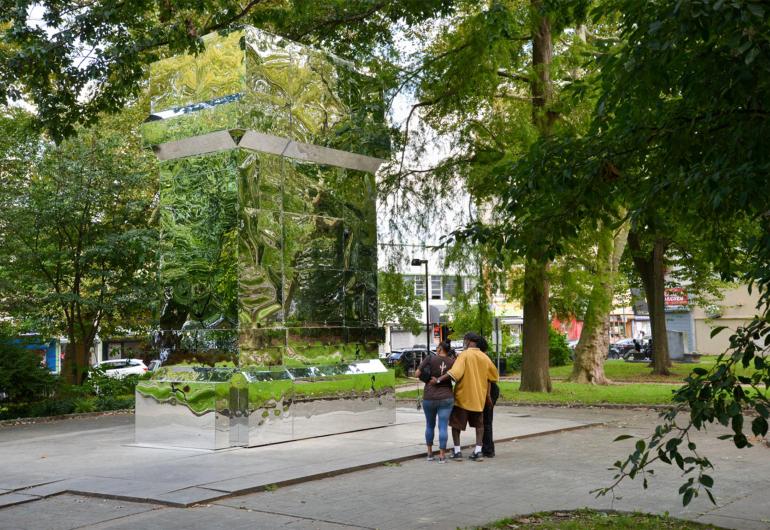Institute for Advanced Study, Northrop, and University Honors Program Present
Public Monuments in the Human Landscape
Past event
Nov 10, 2022
Captioning

Katrina Phillips, Associate Professor of History, Macalester College and Monument Lab Advisory Board
Jean M. O’Brien, Distinguished McKnight University Professor and Northrop Professor of History at the University of Minnesota
Robyne Robinson, journalist, advocate, and arts consultant
Public art and monuments are extremely visible components of our civic life, but do these symbols truly represent our history and values? Large data sets and catalogs of public art offerings help us to analyze the human landscape, including who is honored in our public spaces, and whose contributions to civic life are misrepresented or unrecognized. Murals visualize communities and current events, and expressing political views can be dangerous for muralists. This panel of scholars and public art practitioners will discuss Monument Lab’s National Monument Audit as well as regional perspectives on our substantial, but incomplete, collection of murals and monuments.
Panelists
Jean M. O’Brien (citizen, White Earth Ojibwe Nation) is Distinguished McKnight University Professor and Northrop Professor of History at the University of Minnesota. She is a co-founder and past president of the Native American and Indigenous Studies Association and inaugural co-editor (with Robert Warrior) of the association’s journal, Native American and Indigenous Studies. She has published seven books, most recently, Allotment Stories: Indigenous Land Relations Under Settler Siege (edited with Daniel Heath Justice, University of Minnesota Press, 2022). Her most recent monograph (with Lisa Blee) Monumental Mobility: The Memory Work of Massasoit, won the inaugural Winthrop Prize for the Outstanding Book on Seventeenth-Century New England for 2019-2020 from the Colonial Society of Massachusetts, an honorable mention from the National Council on Public History, and was a finalist for the Best Subsequent Book from the Native American and Indigenous Studies Association. O’Brien is an elected member of the Society of American Historians and was elected a member of the American Academy of Arts and Sciences in 2022.
Katrina Phillips is an Associate Professor of History with a focus on Native history and the history of the American West. Born and raised in northern Wisconsin, Professor Phillips is a proud citizen of the Red Cliff Band of Lake Superior Ojibwe. She earned a BA and PhD in History from the University of Minnesota and spent two years as a Consortium for Faculty Diversity fellow before joining the ranks of the Macalester faculty in 2016. She is the author of Staging Indigeneity: Salvage Tourism and Performances of Native American History and is currently at work on “there are rocks in between”: Activism, Environmentalism, and Tourism in Northern Wisconsin. As a public historian, Phillips’s work has appeared in the “Made By History” section of the Washington Post; she’s appeared on Native America Calling, NPR’s 1A, and Indigeneity Rising.
Robyne Robinsonhas had a commanding presence in the Minnesota Arts community as an entrepreneur, advocate, journalist, designer, and consultant. During her tenure as Art Director and fiveXfive Consultant at Minneapolis-St. Paul International Airport, Minnesota received more than $5 million in art commissions for performances, displays and art installations created by Minnesota and Upper Midwest artists. Robinson created an Emmy-winning platform for Minnesota Arts during her years as a TV news anchor-reporter at Fox 9 News. She also made financial education and business development in the arts one of her key initiatives as a 2010 candidate for Lt. Governor of Minnesota. Robinson has served on numerous arts boards including the Walker Art Center, Minneapolis College of Art and Design (MCAD), and the Minnesota Museum of American Art, where she served as Board Chair.
Photo credit: The Battle is Joined (2017), Karyn Olivier, courtesy Monument Lab. Learn more about the monument and artist.
This Fall, the Spotlight Series brings together thought leaders to explore how geography and mapping practices inform identity, history, and the question of personal responsibility. The content below derives from the Northrop Across Campus Program that supports Northrop's mission towards intersections between community and education for the benefit of all participants now and for generations to come.
Find ways to make thematic connections to these suggested topics in the fall sessions.
Take a deeper dive into these resources for the fall sessions that provide more information about the speakers, the history of the topics being discussed, and where you can learn more about the subject matter.
Start a conversation or reflect on this event using these questions as inspiration.
The Monument Lab is a nonprofit public art and history studio that aims to disrupt the status quo of how monuments are made, preserved, and interpreted. The National Monument Audit, a partnership between The Monument Lab and the Andrew W. Mellon Foundation, aims to assess the current monument landscape in America, and found that "the story of the United States as told by our current monument landscape misrepresents our history."